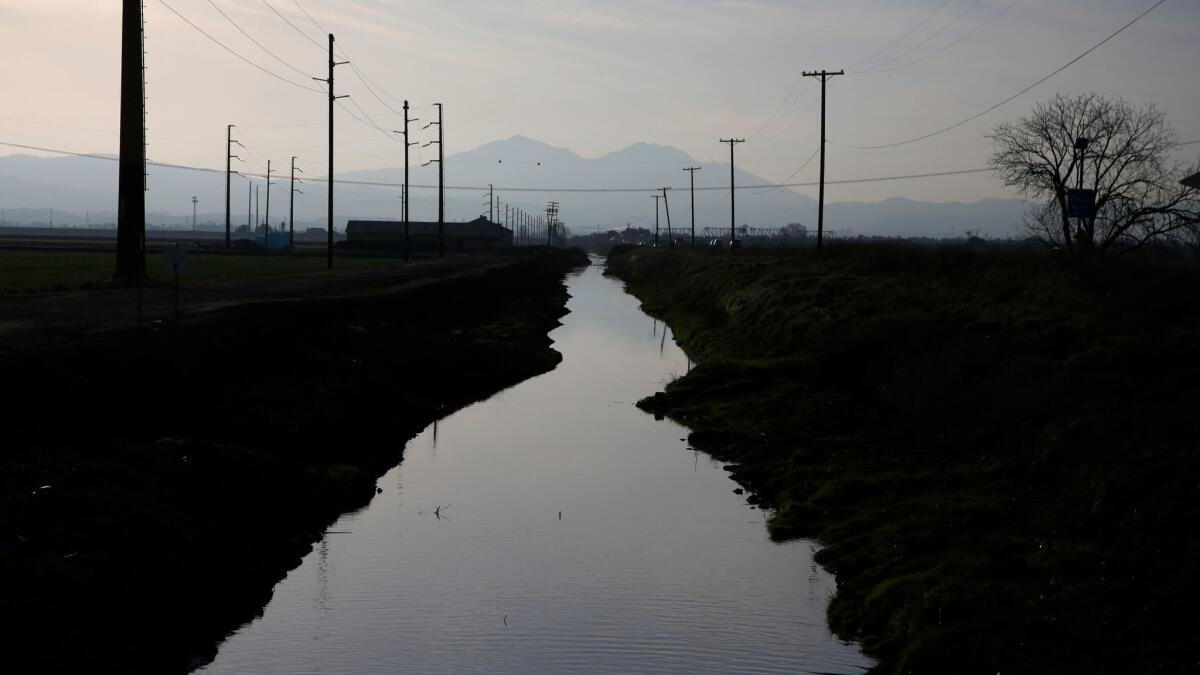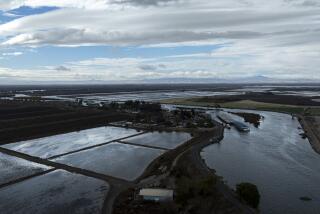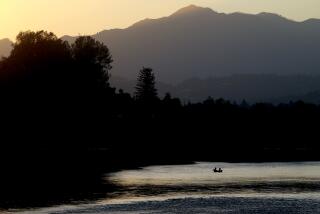Editorial: Dead dogs and toxic fish: Welcome to Stockton, a city choking on California water policy

Stockton is a city simultaneously in recovery and under stress. The municipality of about 300,000, some 50 miles south of Sacramento and 80 miles east of San Francisco on California’s extraordinary inland delta, became the largest U.S. city to file for bankruptcy in 2012 (Detroit followed in 2013). It was then, and remains today, one of the nation’s most violent cities, and it still struggles with deep poverty, even as its emergence from insolvency sparks civic renewal and innovation.
The city’s fate is linked inextricably with the San Joaquin River, which runs through town after its long trip down the western slope of the Sierra and a sharp turn north through the San Joaquin Valley. Much of the water upstream is diverted for agriculture, although a legal settlement ensures that the river no longer runs dry. Additional diversions at the downriver end — this time for urban as well as agricultural use — greatly reduce the amount of water that actually makes it through the Sacramento-San Joaquin River Delta, the San Francisco Bay and then the Pacific. It is as if one of the state’s two great arteries (the other being the Sacramento River) is detached from its heart.
The river both unites and divides Stockton’s people. Many of the wealthy use marinas and live in riverside homes with boat slips. Working-class residents fish the increasingly polluted sloughs and adjacent creeks to put food on the table.
Health officials try to dissuade them. Consumption of south delta fish should be limited, in part because of accumulated mercury dating back to Gold Rush mining. In addition, the city, being at the river’s low point, and now lacking the natural unimpeded flow of water that otherwise would flush the sloughs and creeks, is a gathering spot for nitrates and other pollutants that flow from the fields upriver.
One result is blue-green algal bloom and its cyanotoxins that turn the water into greenish, deadly poison. Stories are told of dogs wading into the sloughs and never emerging. Thousands of indigent Stocktonians who lost their homes now camp by those same sloughs, using the noxious water to bathe, cook and fish.
Meanwhile, a warming climate threatens to make the toxic blooms more frequent, and at the same time rising sea levels are likely to push saltwater upstream, wrecking the groundwater for delta irrigation and urban use. Weakened by diversions, the river lacks sufficient water to push back against the salt or to flush out the toxins.
In nationwide studies of extreme poverty, Stockton frequently vies with two other San Joaquin Valley cities — Fresno and Bakersfield, where river-irrigated farmlands make growers rich but leave tens of thousands of residents in poverty — for the dubious honor of being listed among the most destitute. More people live in degraded environmental conditions in Stockton than in any other part of California, and the city’s polluted waterways tend to run alongside its neighborhoods of deepest poverty, highest incidents of asthma and most frequent violent crime.
Last month, the Trump administration unveiled its long-promised plan to divert even more water from the delta and southward to the expanding San Joaquin Valley fields that produce almonds, pistachios and other lucrative crops. If seen through to completion, the move will push not just the famous delta smelt but also winter-run Chinook salmon closer to extinction and, with them, the orcas that feed on salmon offshore. To environmentalists who see the delta-river system as the great salmon migratory highway that it is, the additional diversions portend environmental collapse.
They are correct, but it’s not only the fish, fishing industry, the orcas and the ecosystem that are in jeopardy.
It is also the people of Stockton and those other communities up and down the river that live or die on the flow of water through their cities. It is the heart of California, sacrificed for more politically connected areas. It is multi-generational delta farming families, losing their water to newer, larger farms to the south. The contest is not farms versus fish. It is money versus people, political clout versus the powerless, the haves versus the have-nots.
Soon after taking office this year, Gov. Gavin Newsom demonstrated a fresh and welcome commitment to the San Joaquin Valley and its people, especially those in communities in Fresno and Tulare counties left dry by agricultural over-pumping.
But he is, at the same time, seeking a way around state rulings requiring agricultural interests to restore a modest amount of water to the San Joaquin River and its tributaries. (That’s separate from the Trump program which, if allowed to go forward, would take even more water.)
Some of the water that the Trump administration has ordered to be diverted from the rivers would flow to Southern California faucets as well as Central Valley nut orchards. But surely Los Angeles did not sign up for this — for policies that drain rivers, degrade the natural environment and leave cities in other parts of the state to choke on toxic algae and intruding saltwater. Our survival does not require snuffing out salmon, Stocktonians or our neighbors in other parts of the state.
Californians share a land with a precious and limited water supply that must sustain the fragile environment and struggling urban areas, not just the politically connected portion of the agricultural economy. It falls to Newsom to fight, not join, the Trump administration’s drive to squeeze more water out of California’s rivers, its environment, its fish and — more to the point — its people.
More to Read
A cure for the common opinion
Get thought-provoking perspectives with our weekly newsletter.
You may occasionally receive promotional content from the Los Angeles Times.






